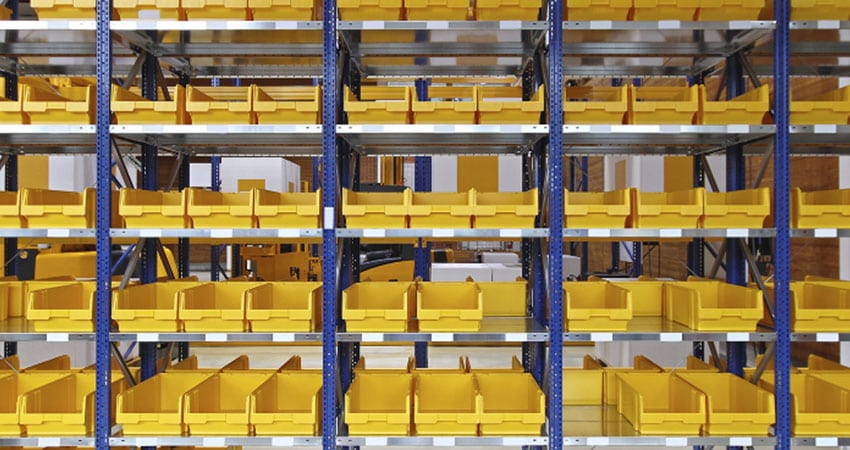There are sophisticated commercial software packages that assist with slotting planning and maintenance in an ecommerce warehouse. Many company’s operations are not ready for a fully automated system, especially the capital investment and continuing maintenance required.
However almost every ecommerce warehouse can benefit from applying some basic slotting methodology. We will provide an analysis that any warehouse can put in place and gain many benefits.
Slotting is the process of assigning SKUs to picking locations based on various criteria such as unit sales velocity, size, weight or family group. The main objectives in any slotting exercise are to reduce operational costs, make more efficient use of space and minimize replenishment.
Benefits of Effective Slotting
Some of the many benefits of effective slotting:
- Decrease operating costs – as much as 60% to 75% of picker’s time is travel. Effective slotting can reduce travel significantly, lowering the cost per unit picked.
- Improve storage capacity – right-sizing pick slots based on product cube and sales velocity improves space utilization, which can often delay expansion or the need for a warehouse move.
- More efficient picks – better locations for advertised or seasonally promoted products; “hot pick” high volume items; and products that often sell together.
- Improved ergonomics – fast-moving units placed in “golden zones,” i.e. locations that are easier to pick from, with no bending or reaching. This improves order cycle time, reduces replenishment trips and reduces put-away and picking time.
- Increased accuracy – by separating similar products or SKUs that could be mis-picked.
- Load and zone balancing of work – reduces congestion and contention for material handling equipment.
Create an Analysis Report
This type of report allows you to analyze product movement for a period of time, generally a season or a year. This should be done in one of two ways:
- Unit sales: From the item master file, analyze unit sales velocity. Sequence the report by product, showing unit sales highest to lowest.
- Frequency of ordering: Develop the report as above sorted by highest item sales to slowest selling and show the number of orders the product appeared on. This will give you an approximate number of trips to pick the SKU.
- Next, for each SKU, calculate what percentage of the total unit sales is represented by each item. Once you’ve done this, create a cumulative percentage of sales column. This column is a cumulative running total that will show you the number of SKUs which make up each 10% of sales (i.e. the first 10%, second 10%, etc.). For most companies the 80/20 rule holds: 80% of the sales come from 20% of the SKUs. The top 20% of SKUs should be the primary location focus in slotting.
Obviously, from an order picking efficiency perspective, the item that was picked a hundred times should be in a more accessible slot than products with little movement. Remember it is better to have the number of times picked rather than just unit sales. Consumer businesses can use unit sales because of the small order nature. Business-to-business sellers may benefit more from number of trips if they have large pulls of the same products.
Applying Slotting Results
After creating the analysis, determine how your ecommerce warehouse needs to be re-slotted. Where do fast sellers need to be stored to eliminate travel time, and how accessible are these slots? Take into account potential congestion you may accidentally create.
Storage types and product characteristics: How does this affect your potential slotting? Are there changes to the layout needed to benefit from slotting?
Right-sizing slots: Two aspects are important. Variable sized slots based on a product’s cube and forward pick areas which, if possible, should store four to seven days of unit sales. This reduces replenishment trips and congestion.
Employee safety: Does current slotting cause pickers to be inefficient or even dangerous? Examples: Picking from a ladder or forklift when the items should be at lower levels or in forward pick areas.
Ship-alone product: Large, oversized product and hazmat items are products should not be consolidated with other items. Consider storing them in a separate zone or facility to better use space.
Ongoing Slotting
To gain the benefits from slotting, the process needs to be addressed continually and the warehouse re-slotted when product assortment or sales by product change. Treat slotting as a critical process just like you do inventory accuracy. Who in your organization will you task with this responsibility to continually get the benefits?
Slotting is one activity that most businesses with an ecommerce warehouse do not spend enough time with on a regular basis. Start out with this analysis approach, gain some quick wins and then research the cost/benefit of moving to a more automated application.
Brian Barry is President of F. Curtis Barry & Company

